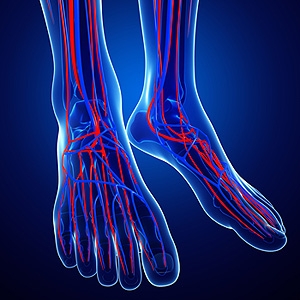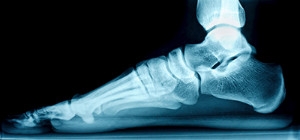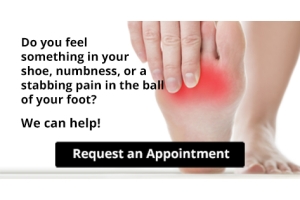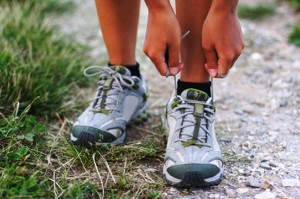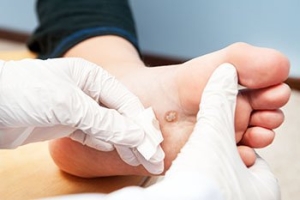Connect With Us
Featured Articles

Why Do I Need an Ankle-Brachial Index Test?
 The Ankle-Brachial Index (ABI) test is a simple, fast, and noninvasive screening tool used to detect peripheral artery disease (PAD), a condition that causes poor circulation in the lower limbs. A doctor may suggest that you undergo an ABI test if you are at risk for or have symptoms of PAD. People who are older than 70, have diabetes, high lipid levels, smoke, or have abnormal pulses in their legs can have an increased risk of developing PAD. While usually asymptomatic in its earliest stages, PAD can progressively worsen and cause leg pain, cramps, and numbness, among other symptoms. An ABI test is done by measuring the blood pressure at your arm and at your ankle using a blood pressure cuff. The two numbers are then compared to each other to determine your risk of PAD. For more information about PAD, please consult with a podiatrist.
The Ankle-Brachial Index (ABI) test is a simple, fast, and noninvasive screening tool used to detect peripheral artery disease (PAD), a condition that causes poor circulation in the lower limbs. A doctor may suggest that you undergo an ABI test if you are at risk for or have symptoms of PAD. People who are older than 70, have diabetes, high lipid levels, smoke, or have abnormal pulses in their legs can have an increased risk of developing PAD. While usually asymptomatic in its earliest stages, PAD can progressively worsen and cause leg pain, cramps, and numbness, among other symptoms. An ABI test is done by measuring the blood pressure at your arm and at your ankle using a blood pressure cuff. The two numbers are then compared to each other to determine your risk of PAD. For more information about PAD, please consult with a podiatrist.
Vascular testing plays an important part in diagnosing disease like peripheral artery disease. If you have symptoms of peripheral artery disease, or diabetes, consult with Dr. Thong V. Truong from California. Our doctor will assess your condition and provide you with quality foot and ankle treatment.
What Is Vascular Testing?
Vascular testing checks for how well blood circulation is in the veins and arteries. This is most often done to determine and treat a patient for peripheral artery disease (PAD), stroke, and aneurysms. Podiatrists utilize vascular testing when a patient has symptoms of PAD or if they believe they might. If a patient has diabetes, a podiatrist may determine a vascular test to be prudent to check for poor blood circulation.
How Is it Conducted?
Most forms of vascular testing are non-invasive. Podiatrists will first conduct a visual inspection for any wounds, discoloration, and any abnormal signs prior to a vascular test.
The most common tests include:
- Ankle-Brachial Index (ABI) examination
- Doppler examination
- Pedal pulses
These tests are safe, painless, and easy to do. Once finished, the podiatrist can then provide a diagnosis and the best course for treatment.
If you have any questions, please feel free to contact our office located in Chico, CA . We offer the newest diagnostic and treatment technologies for all your foot care needs.
Vascular Testing in Podiatry
In foot care, vascular testing may be required in the diagnosing and treatment of certain podiatric conditions. Vascular testing is particularly relevant for patients with high-risk diabetes, poor circulation, peripheral artery disease (PAD), and chronic venous insufficiency (CVI). Procedures typically involve the examination of blood vessels throughout the body for blockages or buildup.
Vascular testing is very important for the diagnosis of various conditions, including peripheral artery disease and chronic venous insufficiency, as these conditions can greatly affect one’s quality of life and cause pain in the lower limbs. Circulatory problems in the feet and ankles can reflect issues throughout the body, making testing of the blood vessels pertinent.
Testing methods vary between practitioners and can be specific to certain foot and ankle problems. Modern technology has brought about the ability to perform vascular testing using non-invasive methods, such as the cuff-based PADnet testing device. This device records the Ankle-Brachial Index (ABI)/Toe-Brachial Index (TBI) values and Pulse Volume Recording (PVR) waveforms. Contact your podiatrist to determine what vascular testing is available for your needs.
What Are the Signs of Flat Feet?
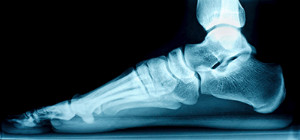 Flat feet are a common condition in which the feet lack a visible arch in the sole when weight is placed on them. There are several telltale signs of flat feet. The first is overpronation, an abnormal gait in which your feet roll inwards when you walk. If you have an overpronated gait, you may notice that the soles of your shoes wear more quickly along the inner border. Other signs of flat feet include having feet that point slightly outward when you walk or stand, pain in the joints of your lower limbs, hips, and lower back, and pain in the arch of the foot. If you are experiencing discomfort due to flat feet, please see a podiatrist for treatment.
Flat feet are a common condition in which the feet lack a visible arch in the sole when weight is placed on them. There are several telltale signs of flat feet. The first is overpronation, an abnormal gait in which your feet roll inwards when you walk. If you have an overpronated gait, you may notice that the soles of your shoes wear more quickly along the inner border. Other signs of flat feet include having feet that point slightly outward when you walk or stand, pain in the joints of your lower limbs, hips, and lower back, and pain in the arch of the foot. If you are experiencing discomfort due to flat feet, please see a podiatrist for treatment.
Flatfoot is a condition many people suffer from. If you have flat feet, contact Dr. Thong V. Truong from California. Our doctor will treat your foot and ankle needs.
What Are Flat Feet?
Flatfoot is a condition in which the arch of the foot is depressed and the sole of the foot is almost completely in contact with the ground. About 20-30% of the population generally has flat feet because their arches never formed during growth.
Conditions & Problems:
Having flat feet makes it difficult to run or walk because of the stress placed on the ankles.
Alignment – The general alignment of your legs can be disrupted, because the ankles move inward which can cause major discomfort.
Knees – If you have complications with your knees, flat feet can be a contributor to arthritis in that area.
Symptoms
- Pain around the heel or arch area
- Trouble standing on the tip toe
- Swelling around the inside of the ankle
- Flat look to one or both feet
- Having your shoes feel uneven when worn
Treatment
If you are experiencing pain and stress on the foot you may weaken the posterior tibial tendon, which runs around the inside of the ankle.
If you have any questions please feel free to contact our office located in Chico, CA . We offer the newest diagnostic and treatment technologies for all your foot and ankle needs.
What is Flexible Flat Foot?
Flatfoot is classified as having the entire sole of the foot in contact or near contact to the ground while standing. The disorder is also known as fallen arches, because those affected have no arch in their feet. Flexible flatfoot and rigid flatfoot are the two types of flatfoot.
A person has flexible flatfoot if when sitting or standing on their toes, they have an arch that disappears when they stand with the entire foot on the ground. Flexible flatfoot may also be called “pediatric flatfoot” because the condition first appears in childhood. It is common among infants because the arch does not develop until the age of 5 or 6 years. Rigid flatfoot is not as common in children as it is with adults. This type of flatfoot is developed due to the weakening of tibialis posterior muscle tendon, a major supporting structure of the foot arch. Development of this deformity is progressive and shows early signs of pain and swelling that begins at the inside arch of the foot and moves to the outside of the foot below the ankle. More severe cases can possibly lead to arthritis of the foot and ankle joints.
Although most cases of flatfoot involve people born with the condition, some less common causes are obesity, diabetes, pregnancy, and osteoporosis. In some cases, flatfoot may come with no symptoms at all and does not require any type of treatment. With other cases though, symptoms may include pain in the shin, knee, hips and lower back. If a person with flatfeet experiences such symptoms, a health care provider may suggest using orthotic devices or arch supports, which may reduce the pain. Wearing supportive shoes can also prove more comfortable with flatfeet and staying away from shoes with little support such as sandals. Other methods to relieve pain also include stretching the Achilles tendon properly and using proper form when doing any physical activity. In addition, losing weight can reduce the stress on your feet and reduce the pain.
Why Live with Pain and Numbness in Your Feet?
How to Make Sure Hiking Shoes Fit Correctly
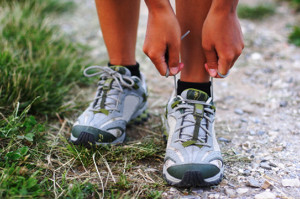 Because of the stress put on the feet while hiking, having shoes that fit properly is very important. Hiking boots should feel snug but not tight, and there should be enough room for wiggling the toes. In order to ensure a proper fit, there are a few things that can be done when choosing hiking boots. Shoes should be tried on at the end of the day or after exercise because people’s feet swell during the day. When trying on shoes, it is also important to wear the same socks and orthotics that you plan to wear while hiking in order to understand the impact they will have on the fit. There should also be proper spacing between the end of the toes and the edge of the shoe, and the shoes should have a proper width where the toes aren’t scrunched up. If you would like more information on making sure your shoes fit properly, consult with a podiatrist who will help provide tips for a proper shoe fit.
Because of the stress put on the feet while hiking, having shoes that fit properly is very important. Hiking boots should feel snug but not tight, and there should be enough room for wiggling the toes. In order to ensure a proper fit, there are a few things that can be done when choosing hiking boots. Shoes should be tried on at the end of the day or after exercise because people’s feet swell during the day. When trying on shoes, it is also important to wear the same socks and orthotics that you plan to wear while hiking in order to understand the impact they will have on the fit. There should also be proper spacing between the end of the toes and the edge of the shoe, and the shoes should have a proper width where the toes aren’t scrunched up. If you would like more information on making sure your shoes fit properly, consult with a podiatrist who will help provide tips for a proper shoe fit.
It is important to find shoes that fit you properly in order to avoid a variety of different foot problems. For more information about treatment, contact Dr. Thong V. Truong from California. Our doctor will treat your foot and ankle needs.
Proper Shoe Fitting
Shoes have many different functions. They cushion our body weight, protect our feet, and allow us to safely play sports. You should always make sure that the shoes you wear fit you properly in order to avoid injuries and deformities such as: bunions, corns, calluses, hammertoes, plantar fasciitis, stress fractures, and more. It is important to note that although a certain pair of shoes might be a great fit for someone else, that doesn’t mean they will be a great fit for you. This is why you should always try on shoes before buying them to make sure they are worth the investment. Typically, shoes need to be replaced ever six months to one year of regular use.
Tips for Proper Shoe Fitting
- Select a shoe that is shaped like your foot
- Don’t buy shoes that fit too tight, expecting them to stretch to fit
- Make sure there is enough space (3/8” to ½”) for your longest toe at the end of each shoe when you are standing up
- Walk in the shoes to make sure they fit and feel right
- Don’t select shoes by the size marked inside the shoe, but by how the shoe fits your foot
The shoes you buy should always feel as good as they look. Shoes that fit properly will last longer, feel better, and improve your way of life each day.
If you have any questions, please feel free to contact our office located in Chico, CA . We offer the newest diagnostic and treatment technologies for all your foot care needs.
Proper Shoe Fitting
When it comes to maintaining foot health, wearing properly-fitting shoes is important. While wearing the appropriate pair of shoes may seem like a trivial concern, the reality is that improperly fitted shoes cause an astounding amount of injuries to the feet. The overall structure and the biomechanics of our bodies are directly affected by our posture, gait, and feet. Because of this, pain and discomfort felt throughout the body are often related to a problem in the feet. And, most foot problems usually stem from improper footwear.
Shoes should not be purchased with the expectation that they will easily stretch and contort to the size and shape of your feet. When shopping for footwear, look for shoes that fit correctly and comfortably as soon as you put them on. Do not purchase shoes that are too large or that slip in the heel area when you walk. Do not choose shoes that are loose with the intention of wearing thicker socks to compensate for the space. The widest portion of the shoe, the ball of the foot, must be made sure to fit comfortably in the shoe.
Keeping all of these suggestions in mind may be difficult when shopping and when trying to select from a wide array of different shoes. Nonetheless, your time and money will be wasted if you purchase a pair of shoes that are too uncomfortable for you to actually wear them. After finally selecting and purchasing a pair of shoes, try them on at home. To truly ensure whether or not your shoes fit comfortably with normal activity, walk around on a carpeted surface to determine how they feel on your feet.
The possibility of damaging your feet’s 33 joints, 26 bones, and 100+ ligaments is much higher than many people suspect. Finding an appropriate and properly-fitted pair of shoes is perhaps the single most important action you can take to maintain excellent foot health and help prevent injury. The fact that our feet continue to change with age is one that many people often forget. Even if our feet no longer change in size when we mature, our feet will still change in shape.
If you already have pre-existing foot problems, there is a greater possibility that wearing improperly-fitted shoes will worsen those problems. The good news, however, is that appropriate footwear is not difficult to find. While shopping for shoes, remember that improper footwear can detrimentally affect the feet, the entire body and its biomechanical structure as well. The shoes you wear can greatly impact your legs, back, and entire body, as your posture and gait are related to your feet. Finding and selecting the best properly-fitted shoes is necessary in achieving optimal health.
Where Do Plantar Warts Grow?
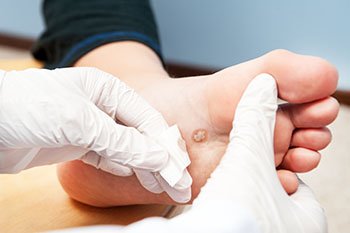 The human papillomavirus (HPV) is responsible for the development of plantar warts. They are defined as warts that form on the heel and bottom of the foot. Plantar warts grow inward as a result of the pressure the feet endure from walking and standing for the majority of the day. They can cause severe pain and discomfort, and may affect the way you walk. The virus that causes this uncomfortable foot condition is often found in public swimming pools, locker rooms, and shower room floors. Plantar warts may be prevented when appropriate shoes are worn in these types of areas. Additionally, it is beneficial to refrain from sharing towels, socks, and shoes. If you have developed a plantar wart, it is strongly suggested that you are under the care of a podiatrist who can guide you toward the treatment options that are best for you.
The human papillomavirus (HPV) is responsible for the development of plantar warts. They are defined as warts that form on the heel and bottom of the foot. Plantar warts grow inward as a result of the pressure the feet endure from walking and standing for the majority of the day. They can cause severe pain and discomfort, and may affect the way you walk. The virus that causes this uncomfortable foot condition is often found in public swimming pools, locker rooms, and shower room floors. Plantar warts may be prevented when appropriate shoes are worn in these types of areas. Additionally, it is beneficial to refrain from sharing towels, socks, and shoes. If you have developed a plantar wart, it is strongly suggested that you are under the care of a podiatrist who can guide you toward the treatment options that are best for you.
Plantar warts can be very uncomfortable. If you need your feet checked, contact Dr. Thong V. Truong from California. Our doctor will assist you with all of your foot and ankle needs.
About Plantar Warts
Plantar warts are the result of HPV, or human papillomavirus, getting into open wounds on the feet. They are mostly found on the heels or balls of the feet.
While plantar warts are generally harmless, those experiencing excessive pain or those suffering from diabetes or a compromised immune system require immediate medical care. Plantar warts are easily diagnosed, usually through scraping off a bit of rough skin or by getting a biopsy.
Symptoms
- Lesions on the bottom of your feet, usually rough and grainy
- Hard or thick callused spots
- Wart seeds, which are small clotted blood vessels that look like little black spots
- Pain, discomfort, or tenderness of your feet when walking or standing
Treatment
- Freezing
- Electric tool removal
- Laser Treatment
- Topical Creams (prescription only)
- Over-the-counter medications
To help prevent developing plantar warts, avoid walking barefoot over abrasive surfaces that can cause cuts or wounds for HPV to get into. Avoiding direct contact with other warts, as well as not picking or rubbing existing warts, can help prevent the further spread of plantar warts. However, if you think you have developed plantar warts, speak to your podiatrist. He or she can diagnose the warts on your feet and recommend the appropriate treatment options.
If you have any questions please feel free to contact our office located in Chico, CA . We offer the newest diagnostic and treatment technologies for all your foot and ankle needs.
All About Plantar Warts
Plantar warts are warts that are only found on the feet, hence the term “plantar”, which means “relating to the foot.” They are caused by the human papillomavirus, or HPV, and occur when this virus gets into open wounds on the feet. The warts themselves are hard bumps on the foot. They are easily recognizable, mostly found on the heels or ball of the foot. Plantar warts are non-malignant, but they can cause some pain, discomfort, and are often unsightly. Removing them is a common step toward treating them.
Plantar warts can cause some pain while standing, sometimes felt as tenderness on the sole of your foot. Unless the wart has grown into the foot behind a callus, you will be able to see the fleshy wart. A podiatrist should only be consulted if there is an excessive amount of pain. Plantar warts are not cancerous or dangerous, but they can affect your walking and continually reappear. Anyone who suffers from diabetes or a compromised immune system disease should seek out care immediately.
Podiatrists are easily able to diagnose plantar warts. They usually scrape off a tiny bit of the rough skin to make tiny blood clots visible and examine the inside of warts. However, a biopsy can be done if the doctor is not able to diagnose them from simply looking at them. Although plantar warts usually do not require an excessive amount of treatment, there are ways to go about removing them. A common method is to freeze them off using liquid nitrogen, removing them using an electrical tool, or burning them off via laser treatment. For a less invasive treatment option, topical creams can be used through a doctor’s prescription. This treatment method takes more time, however. Keep the wart covered for protection in between daily treatments.
The best way to avoid developing plantar warts is to avoid walking barefoot in public places. Avoid this especially if you have open sores or cuts on your feet. It is also important to avoid direct contact with warts in general, as they are highly contagious.
